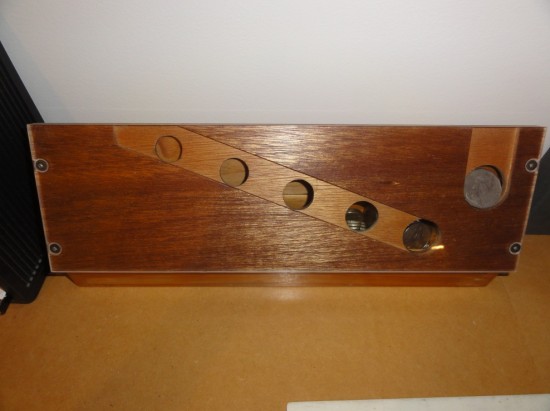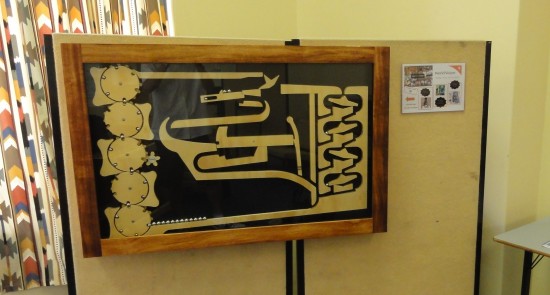Interactive Donation Box – Folio
I just thought that i would post up my project's portfolio here for people wanting to read about its development, or for people who are doing D&T for their HSC and need a bit more of an idea on what needs to go into a portfolio. A bit of a disclaimer though if you fall into this category, is i have got no marks back yet for this project so i cannot guarantee it is what the DET is looking for in a portfolio.
[download id="26"]
Interactive Donation Box – Behind the scenes
This is a follow up article to explain the inner working of my interactive donation box if you don't have a clue what this is see my other post HERE. Besides all the visible track elements who's operation is clearly visible there are a number of hidden aspects of the machine.
The main part of this is the mechanism for sorting and counting coins (See video below). For this i used a mechanical system of sorting the coins based upon their size. I had originally used this system in a money box that sorted coins into different trays, and knew of a few things that would greatly improve its performance. Firstly to make the back rest out of some kind of plastic material so that its finish will remain much more constant than with wood which gradually changed over time as the finish was absorbed or rubbed off, the other improvement to be made was to use rectangular holes for the coins to fall though instead of circular holes, this just allows the coins longer to fall though their holes, making it virtually impossible for them to miss their hole.
After the creation of this video i made a few change to the sorter to improved it's reliability, mainly replacing the front guide that stops coins jumping off their tracks with a stiffer version to stop 20c coins sometimes escaping off the front.
To detect the coins after they had been sorted i decided upon using a beam break system as this would mean i could reliably detect the coins even without having to worry about if the coins were heavy enough to set off a micro-switch. So i simply have a row of leds on one side of the slots the coins fall though after being sorted and a row of Light dependent resistors on the other, these are hooked up to analog in pins on the arduino controlling the system.
After a coin has been detected the program is quite simple, a certain value is added to the counter depending on what coin has been inserted, the lift i turned on whenever this value is non-zero and the counter is decremented whenever a marble passes a micro-switch hidden within one of the lift guides.
There are only a few things that i would like to do in the future, the main being to reclaim my arduino out of the back of the display, probably replacing it with a MSP430 chip as these are very cheap (under a dollar) meaning i could reclaim my arduino for future projects.
Edit: If you are interested on more details on the construction of this project i have now made my portfolio available HERE.
Interactive Donation Box
Well it was right down to the line but i managed to get my Design and Technology project finished and ready for marking, just... I only had confirmation that all the parts of the project played nicely together after rapidly programming it and getting to put coins into it for the first time at 3AM on the morning it was due. After a quick dash to office works at 7AM i was ready at school to hand my project in on time at 9AM.
Even though the projects design had to be greatly modified from its original 3 window design a I am really happy with how well the project has turned out and with all of the really positive responses I have got from other students and teachers. Without any more words here is the project.
Just in-case you haven't read my previous posts from way back about what the donation box actually is, here is a quick summary.
When somebody puts a coin into the machine it is sorted by currency and depending on the value of the coin a certain number of marbles are sent though a marble run (i decided on the rate of 1 marble per 10c). The idea of the project is that if it is made more interesting for people to donate then people are much more likely to make a contribution.
To better display this here is a video of the project in action
Also thanks to MWandel of woodgears.ca for his gear template generator and general articles on marble machines that made me pick this as a project
After i finish up with UNI preferences and scholarship applications i will hopefully have some more info up on what goes on behind the project
Edit: I now have another post up detailing some of the inner workings of the project HERE
Edit: If you are interested on more details on the construction of this project i have now made my portfolio available HERE.
Marble run plans complete
Well after lots of screwing around in Autodesk Inventor I finally have the final plan drawn up for the marble run portion of the machine.
I have also made a major change to my expected overall design, making it a much flatter design, making for simpler parts and less supports needed.
I started just doing one small portion of the mechanism i decided to call the dripper because it "drips" marbles, from this i also had a go at running dynamic simulations and managed to run and test the "dripper" and render a video of how it went.
More recently I have also rendered an image of the whole setup (without the cabinet, pivots ect) and can be found HERE (my thumbnail generator is not working properly)
I have printed out templates for all of the pieces and plan on cutting these out as MDF templates some time next week.
Donation box prototypes
I have begun to plan and design some aspects of the marble run window of my interactive donation box. There are two main aspects i have been focusing on so far are, ways to lift the marbles back to the starting point and different track elements for on the way down. For both of these i have begun the construction of cardboard prototypes.
Marble lift
There are a few different methods that are used to lift marbles, the main ones being screw based or disk based, i have decided that it would be much easier to go with the disk design as it would be much easier to manufacture out of predominantly wood
This video shows my prototype, the final version will have 5 of the wheels and gears to keep the wheels in sync
Track Elements
For my cardboard prototypes it is very difficult to produce any shape with much of a curve, so i have focused on the moving elements of the track. These designs are based off many other marble runs on youtube. This setup is designed to be the elements that will fill one side of the display. In the final version there will be more simple and decorative elements such as spirals and twists to connect the moving elements.
I will hopefully have some more videos of prototypes up in the next few weeks as i work on them.

